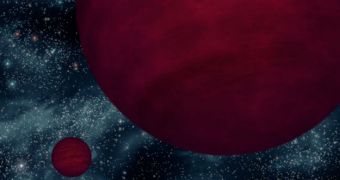A group of astronomers proposes new targets for exoplanetary research, opting to call on their colleagues to focus their attention on some little-studied classes of objects. The team says that free-floating planets and sub-brown dwarfs may provide excellent targets for this type of study.
They explain that, throughout the Universe, numerous extrasolar planets are thrown out of the solar systems where they were produced, and sent to wonder through space all alone. Life may have developed on this world, experts say, and may endure there still.
On the other hand, sub-brown dwarfs are a class of celestial bodies that blur the edge of separation between massive gas giants and small stars. In their behavior, these bodies behave more like planets, but astronomers are still having a tough time cataloging them.
In the new studies, the astronomers propose that some of these objects could have atmospheric and surface compositions that could allow for the existence of at least some basic lifeforms.
The possibility of life existing on free-floating planets (FFP) and sub-brown dwarfs (SBD) was recently investigated by Viorel Badescu, who is a research scientist at the Polytechnic University of Bucharest, in Romania.
He explains that both classes of objects could contain lakes on their surface, that could be filled with ethane. While life here would differ significantly from Earth's, it would be life nonetheless.
A similar situation – with lakes of liquid hydrocarbons found on the surface – is visible on Saturn's largest moon, Titan. The cosmic body has a nitrogen-rich atmosphere, which also features hydrocarbon rains, winds and storms.
Details of the proposal were published in a recent issue of the journal Planetary and Space Science.
According to Badescu, FFP and SBD may very well exist outside conventional star systems. But, while this provides a new target for research, it also raises a host of technological challenges. Due to their isolation and nature, both classes of bodies are very dim.
This makes them tremendously difficult to detect. However, SBD may be found using infrared telescopes, because they release the thermal energy they contain over billions of years.
“One may expect a rather stable heat release for long periods of time, exceeding two or three times the present age of the solar system,” which is estimated to be about 4.6 billion years, Badescu explained.
“The total number of FFP and SBD may exceed the number of stars by two orders of magnitude, although most of them should be low-mass rock/ice planetary embryos ejected from planetary systems in formation,” he added.
“Thus, it might be conceivable that FFP and SBD are the most common sites of life in the Universe. Present day technology does not allow a systematic search for habitable FFP and SBD,” the expert added.
“However, the existing observation programs of young star forming regions should be supplemented with activities related to FFP and SBD identification and characterization,” he concluded, quoted by Space.

 14 DAY TRIAL //
14 DAY TRIAL //